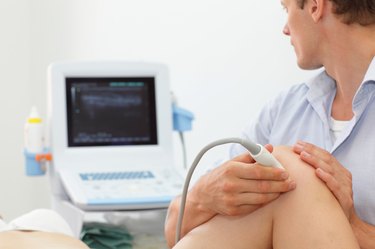
Many conditions can cause chronic knee and leg pain. According to MayoClinic.com, knee pain, including chronic or long-standing knee pain, can be caused by traumatic injuries, overuse injuries and certain medical conditions. Chronic knee and leg pain can be mild, moderate or severe, depending on the condition causing the pain and the tissues involved. In some cases, chronic knee and leg pain can be debilitating, impairing a person's ability to perform the activities of daily living.
Osteoarthritis
Video of the Day
Osteoarthritis, also known as degenerative joint disease, is a common cause of chronic knee and leg pain. According to the American Academy of Orthopaedic Surgeons, or AAOS, knee osteoarthritis is one of the top five causes of disability among older men and women. The loss of smooth articular cartilage—the material that covers the ends of bones where joints are formed—characterizes osteoarthritis. Without sufficient articular cartilage between bones, bone-on-bone forces during movement can cause pain and degenerative changes within the joint. Common signs and symptoms associated with knee osteoarthritis include chronic knee pain, pain and swelling in the affected area during activity, bone spur formation, and knee joint deterioration. Certain risk factors may increase the likelihood of developing knee osteoarthritis, including certain genetic mutations, obesity, advanced age and previous knee trauma.
Video of the Day
IT Band Syndrome
Iliotibial, or IT, band syndrome is a common cause of chronic knee and leg pain, especially among runners. The Sports Injury Clinic website states that the IT band is a thick, fibrous connective tissue sheath that runs down the lateral, or outside, aspect of the knee, eventually inserting into the lateral aspect of the tibia, or shinbone. The IT band assists with extending or straightening the knee and lifting the leg away from the side of the body. With certain repetitive knee movements, the IT band can generate friction and pain in the lateral knee, where it passes over the femur's lateral epicondyle—a bony prominence on the outside aspect of the upper knee. Common signs and symptoms associated with IT band syndrome include chronic pain on the outside of the knee and leg, IT band tightness, pain in the affected area that is worse with running, pain during knee bending or straightening, and trigger points—hyper-irritable muscle nodules or knots—in the buttocks.
Runner's Knee
Runner's knee can cause chronic knee and leg pain. According to the AAOS, runner's knee is a general term used to describe several medical conditions that cause pain around the front of the knee, including anterior knee pain syndrome, patellofemoral misalignment and chondromalacia patella. Common signs and symptoms associated with runner's knee include a dull, aching pain in the front of the patella, or kneecap, where the kneecap joins the lower end of the femur, or thighbone, and knee pain that is worse when ascending or descending stairs, kneeling, squatting and sitting with a bent knee for prolonged periods. Numerous factors can contribute to runner's knee, including misalignment of the kneecap, partial or total kneecap dislocation, traumatic injury, over-training or repetitive strain, thigh muscle tightness or weakness, and flat feet. The AAOS states that most cases of runner's knee can be prevented by stretching, wearing appropriate footwear and staying in good general condition.
Is this an emergency? If you are experiencing serious medical symptoms, please see the National Library of Medicine’s list of signs you need emergency medical attention or call 911.